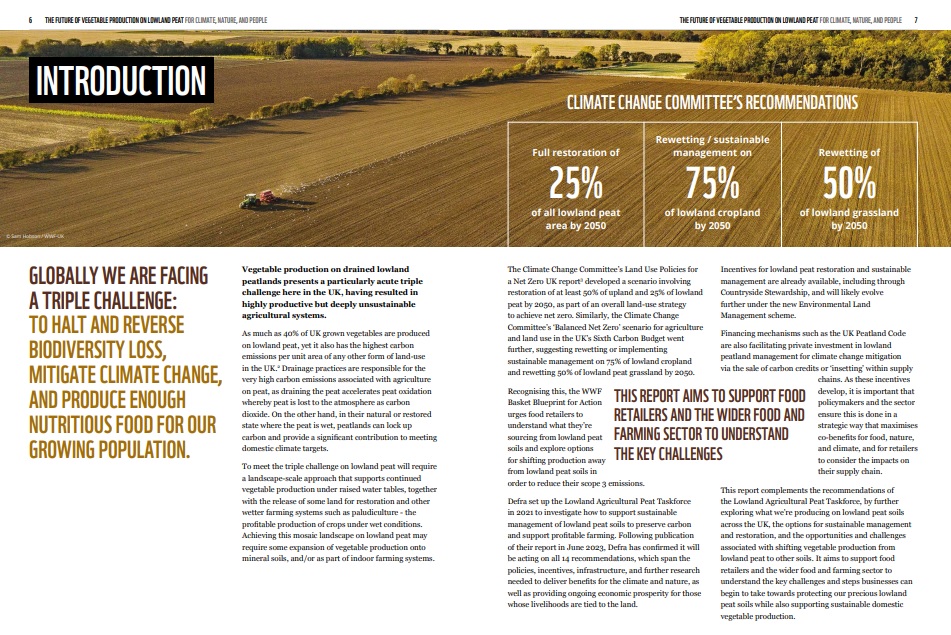A new report has, for the first time, mapped agricultural uses of lowland peat, from vegetables to cereal crops to grassland for beef and dairy production.
The independent study by the UK Centre for Ecology & Hydrology (UKCEH) and NIAB (formerly the National Institute of Agricultural Botany) was commissioned by the WWF and Tesco partnership. It highlights the risks of continuing to drain the UK’s limited areas of lowland peat for intensive cultivation, which releases huge quantities of carbon dioxide (CO2) to the atmosphere while depleting soils that are essential to UK food security.
The UK’s agricultural peatlands are highly productive and important for the national food security. Overall, 40% of UK-grown vegetables are produced on lowland peat, with production concentrated in areas like the East Anglian Fens and Lancashire.
However, agriculture has the highest CO2 emissions per unit area of any form of land-use in the UK because of drainage, with croplands on peat emitting over 1% of UK greenhouse gas emissions from all sources. Therefore protecting these areas by raising water levels is vital if the UK is to achieve its ambition for net zero greenhouse gas emissions, and to halt nature loss.
The Climate Change Committee (CCC) has set ambitious targets for restoration and rewetting of peat by 2050, recommending full restoration of 25% of lowland peat areas in the UK and partial rewetting of a further 50%. But the CCC says progress to date has been limited.
Dr Jenny Rhymes, a greenhouse gas flux scientist at UKCEH, led the report, The Future of Vegetable Production on Lowland Peat.
She says: “To tackle these issues and help to achieve the UK’s ambition for net zero greenhouse gas emissions, we must take a combined, landscape-scale approach that balances the need to protect peat carbon stores with continued vegetable production, based on regenerative farming practices and wetter ways of farming. This may require some expansion of vegetable production elsewhere, on mineral soils or as part of indoor farming systems.
“Our research at UKCEH, alongside collaborations with partners, is exploring solutions that can protect peatlands, maintain food security and protect farmers’ livelihoods across these environmentally and economically important landscapes.”

The report calls on the Government to introduce a comprehensive UK land use framework that sets a long-term future for lowland peat, and a robust strategy to support the horticulture sector in shifting towards more sustainable farming practices in these areas. This would include prioritising crops for human consumption and supporting improved water table management.
A significant proportion of the UK limited areas of lowland peat is being used to produce crops that are not for human consumption, like maize to be processed for biogas and cereals for livestock feed, which the authors say can easily be grown on mineral soils instead.
The report recommends food retailers explore the benefits and trade-offs of sourcing crops off peat in their supply chains, focusing on crops which are equally suited to cultivation on mineral soils, such as potatoes, cereals, sugar beet and winter vegetables. Other recommendations include incentivising suppliers for lower carbon produce and reducing food waste.
The report calls for field trials to show the impact of higher water tables on yield of different crops, to establish which produce can tolerate wetter conditions. It advocates alternative wetter forms of land use such as paludiculture (wetland agriculture) or carbon farming, which adopts land management practices that are known to sequester carbon and/or reduce greenhouse gas emissions.
The authors highlight potential alternative uses for these landscapes to support the shift to net zero, for example through the creation of solar farms on rewetted peat. They also recommend an online decision-making tool to support farmers on lowland peat to understand where land is suitable for different interventions, from continued production to full rewetting.
The full report is available on WWF website.
Further information
The UKCEH authors on the report were: Jenny Rhymes, Jennifer Williamson, Daniel Morton, Joanna Staley, Hannah Young, Amanda Thomson and Chris Evans.